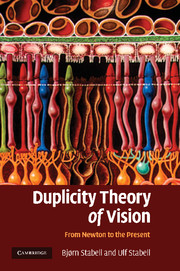Book contents
- Frontmatter
- Contents
- Acknowledgements
- 1 Introduction
- Part I The development of the basic ideas of the duplicity theory from Newton to G. E. Müller
- Part II The development of the duplicity theory from 1930–1966
- 6 The duplicity theory of Polyak
- 7 Investigations of H.K. Hartline and S.W. Kuffler
- 8 The duplicity theory of R. Granit
- 9 Contributions of E.N. Willmer, P. Saugstad & A. Saugstad, and I. Lie
- 10 Status of the duplicity theory in the mid 1960s and its further development
- Part III Chromatic rod vision: a historical account
- Part IV Theories of sensitivity regulation of the rod and cone systems: a historical account
- Part V Factors that triggered the paradigm shifts in the development of the duplicity theory
- References
- Index
8 - The duplicity theory of R. Granit
Published online by Cambridge University Press: 22 January 2010
- Frontmatter
- Contents
- Acknowledgements
- 1 Introduction
- Part I The development of the basic ideas of the duplicity theory from Newton to G. E. Müller
- Part II The development of the duplicity theory from 1930–1966
- 6 The duplicity theory of Polyak
- 7 Investigations of H.K. Hartline and S.W. Kuffler
- 8 The duplicity theory of R. Granit
- 9 Contributions of E.N. Willmer, P. Saugstad & A. Saugstad, and I. Lie
- 10 Status of the duplicity theory in the mid 1960s and its further development
- Part III Chromatic rod vision: a historical account
- Part IV Theories of sensitivity regulation of the rod and cone systems: a historical account
- Part V Factors that triggered the paradigm shifts in the development of the duplicity theory
- References
- Index
Summary
The spikes recorded by Hartline and Kuffler with the microelectrode technique represented end products in a series of consecutive events in the retina, starting with absorption of photons. To gain information about these extremely complex events that preceded the discharges of the optic nerve fibres, the research workers had to rely on the measurements of the electroretinogram (ERG). Indeed, it was generally held that mechanisms underlying the ERG response directly determined the impulse pattern of the optic nerve.
The ERG technique was first employed in 1865 by Frithiof Holmgren, a Swedish physiologist. He applied a pair of electrodes to an eye and found that the galvanometer connected to the electrodes gave a marked deflection both when the eye was illuminated and when the light was turned off. (For a description of the development of this technique, see introduction section of Granit, 1963.)
SUPPORTING EVIDENCE FOR THE DUPLICITY THEORY FROM THE ERG TECHNIQUE
A very extensive review of the research literature on ERG was made by Granit (1947). Presuming that the ERG response represented an average reaction, reflecting the processes of activated photoreceptors, the evidence reviewed was found to support the duplicity theory, suggesting that there were two quite different ERG response patterns of the retina, the so-called E- and I-ERG responses – the former characteristic of rod-dominant and the latter of cone-dominant retinas.
Information
- Type
- Chapter
- Information
- Duplicity Theory of VisionFrom Newton to the Present, pp. 78 - 85Publisher: Cambridge University PressPrint publication year: 2009
